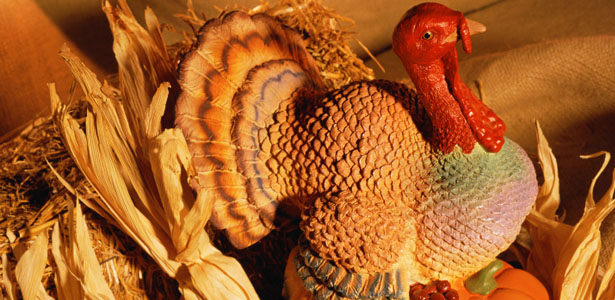When I was a child, my grandmother took old-fashioned clothespins (the kind that are straight and don’t have a hinge) and made “Pilgrims and Indians” out of them. Out of scraps of fabric, she made them clothes. The male Pilgrim had a small Bible in one pipe-cleaner hand and a cane in the other. The female Pilgrim had a white linen apron and a black and white felt cap.
Indigenous people had wonderful robes of colorful wool, and my grandmother found tiny feathers for them to wear (she lived on a farm with baby chicks). The female native had long yarn braids and a colorful band around her head. Grandma also made a decorated tent for the natives. I built a cabin for the Pilgrims out of a building-block set of logs. Every year of my childhood, I brought out these treasures, as did my children as they were growing up. The clothespins have turned a tawny brown color from use and the fabrics are wonderfully worn.
As a child, I had a pretty rosy idea of what Thanksgiving was like. I understood it was a big party, but I didn’t understand what had gone before. However, as I grew older I realized that the Pilgrims that first Thanksgiving had experienced an awful year. They had lost more than half of their number since they’d arrived in what we now call Virginia. Surely there was little to be thankful for.
But they did give thanks to God, and that tells me something. It demonstrates to me that being thankful has very little to do with our circumstances.
John Piper says in his book Desiring God, “The secret to contentment in ‘whatever situation’ is seeing the Treasure that trumps them all.” I heartily agree and have found that to be true in my own life. It also reminds me of what Jesus said in Matthew 13:44 (NIV), “The kingdom of heaven is like treasure hidden in a field. When a man found it, he hid it again, and then in his joy went and sold all he had and bought that field.”
So how do we do that? How do we determine to be thankful, even when the life that surrounds us seems to be bleak?
I’ve found some practical ways that not only help me but my family to focus on what is good at Thanksgiving and throughout the year:
- Create a remembrance box. Using a cardboard box (you can decorate it if you want) and index cards, ask each person to write down one thing they are thankful for and to put it in the box. After dinner, read aloud what each person wrote.
- Another variation on this is to pass around dried indigenous corn. Ask each person to take one kernel and to name one thing they are thankful for.
- Tell the story of the first Thanksgiving. For younger children, use a book such as If You Were at the First Thanksgiving by Anne Kamma. For adults, consider a book such as Thanksgiving: A Time to Remember by Barbara Rainey. Or just brush up on the facts on your own and pretend you are at a storyteller’s convention and make it engaging for all ages. A resource such as Thanksgiving Day Reflections and Ideas can be a great help.
- Read Psalm 107 to your family—and make sure you read it with a lot of expression. Also, discuss how circumstances had nothing to do with being thankful in this psalm.
- Do a Bible study leading up to Thanksgiving to help prepare your own heart. A Life of Giving Thanks includes four articles and four Bible studies that can help you do this.
- Invite someone who would normally be alone at Thanksgiving to join you that day. It will be reminiscent of that first Thanksgiving.
- Fill a basket full of goodies to take to someone in need or simply someone you wish to bless. Bring your kids along so they can be part of it. Even if your circumstances are difficult, it will remind you that you can always give to others.
So, make this Thanksgiving a true celebration. It shouldn’t be about just the food, but about the amazing way God has sustained you and will continue to sustain you. That’s something to be truly thankful for.
Read an earlier post by JoHannah here. [/vc_column_text][/vc_column][/vc_row]

